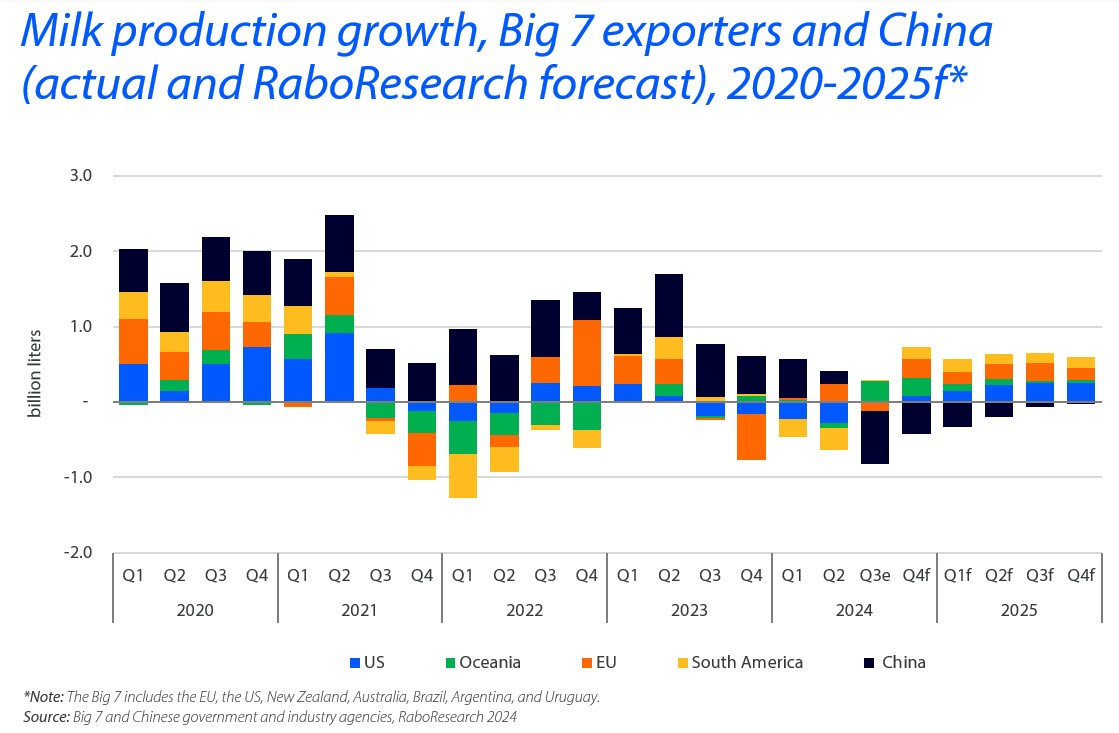



Global dairy market: Further milk supply growth and farmer margin gains expected in 2025
Rising farmgate milk prices and favorable feed costs are improving dairy farm marginsA new RaboResearch report expects milk supply growth from the biggest exporting regions in the second half of 2024. Growth is expected to continue into 2025, with gains anticipated in all major regions for the first time since 2020. Rising farmgate milk prices and favorable feed costs are improving dairy farm margins, while global dairy demand remains mixed amid economic pressures.
Milk supply growth turns positive
“RaboResearch expects 0.5% milk supply growth from the Big 7 export regions in the second half of 2024, driven by significant seasonal peaks in Oceania,” says Michael Harvey, Senior Dairy Analyst at RaboResearch. “Supply growth will maintain its momentum in 2025, with gains expected in all Big 7 exporting regions for the first time since 2020.”
RaboResearch forecasts milk supply growth of 0.8% in 2025. Affordable feed costs and improved weather are supporting milk supply growth.
Farmgate milk prices and margins are on the rise
Firmer commodity prices have flowed through to dairy farmers in export regions, with local farmgate prices improving considerably in the second half of 2024. In parts of Europe and New Zealand, farmgate milk prices are nearing 2022 record highs. Rising milk prices and affordable feed have improved dairy farm margins, which will likely expand further in 2025.

Chinese dairy imports to improve
China has made significant progress in rebalancing stocks, with milk production expected to fall 1.5% year-on-year in 2025.
“We expect China’s three-year run of declining net import volumes to end in 2025, with imports improving by 2% year-on-year,” says Harvey. “This is lead by lower supply and optimism for a recovery in consumer demand.”
Farmgate milk prices are near 10-year lows, triggering herd reductions and farm exits. Dairy demand remains sluggish, but there is some optimism that the bottom of the cycle is near.
Global dairy demand remains mixed
Global dairy demand dynamics remain mixed, with consumer spending still under pressure across many economies. Foodservice channels remain sluggish in most major markets. Retail dairy inflation remains mixed across major markets, with deflation in some markets helping consumers’ budgets.
“Consumers are eating at home more, supporting retail, but there are continuing signs of trading down and some reductions in purchases, particularly in emerging markets. A meaningful lift in incomes and consumer confidence are required to spur dairy demand to more normal settings,” explains Harvey.
Balanced dairy fundamentals and trade uncertainties heading into 2025
“Global dairy fundamentals remain mostly balanced moving into 2025. There are more milk and dairy products in the pipeline, and demand should also improve in 2025. However, geopolitics, disease, and weather could influence trade and production,” cautions Harvey.
“With the election of Donald Trump, markets are watching for the risk of rising US protectionism and potential trade tensions. A reemergence of tariffs could disrupt dairy trade flows, while the threat of mass deportations could disrupt US farm labor availability,” Harvey explains. “Meanwhile, China’s Ministry of Commerce has launched an investigation into EU dairy subsidies that could have far-reaching consequences for European exports of liquid cream and various cheeses.”
Management of disease outbreaks – avian influenza in the US and bluetongue in Europe – is also a key factor to watch. There is optimism that vaccinations for both diseases could mitigate production impacts in 2025.


